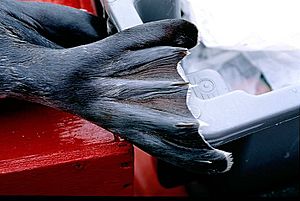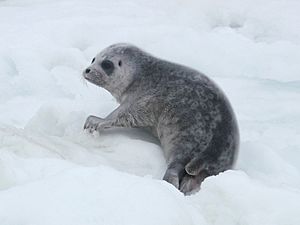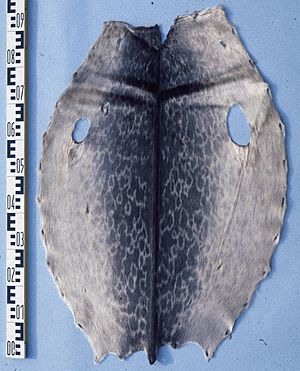Ringed seal facts for kids
Quick facts for kids Ringed seal |
|
|---|---|
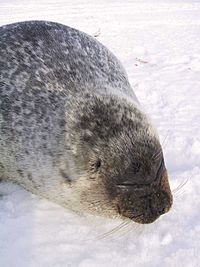 |
|
| Conservation status | |
| Scientific classification | |
| Kingdom: | |
| Phylum: | |
| Class: | |
| Order: | |
| Family: | |
| Subfamily: |
Phocinae
|
| Genus: |
Pusa
|
| Species: |
P. hispida
|
| Binomial name | |
| Pusa hispida (Schreber, 1775)
|
|
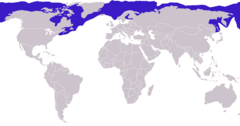 |
|
| Synonyms | |
|
|
|
The ringed seal (Pusa hispida) is a small seal that lives in the cold Arctic and sub-Arctic areas. People also call it the jar seal. The Inuit people, who live in the Arctic, call it netsik or nattiq.
These seals are easy to spot because of their unique look. They have dark spots surrounded by light grey rings on their fur. This is how they got their name! Ringed seals are the most common type of ice seal in the northern part of the world. They live all over the Arctic Ocean. You can find them as far south as Japan in the Pacific and along the North Atlantic coasts near Greenland and Scandinavia. Some even live in freshwater lakes in northern Europe.
Ringed seals are a very important part of the Arctic food web. They are a main food source for polar bears. For a long time, they have also been a key part of the diet for the native people of the Arctic.
Contents
What Do Ringed Seals Look Like?
The ringed seal is the smallest and most common seal in the Arctic. They have a small head and a short, cat-like snout. Their bodies are plump and round.
Their fur is dark, with silver rings on their back and sides. Their belly is usually silver. Adult seals can be from 100 to 175 centimeters (about 3 to 5.7 feet) long. They weigh between 32 and 140 kilograms (about 70 to 308 pounds). On average, a ringed seal is about 1.5 meters (5 feet) long and weighs 50–70 kilograms (110-150 pounds).
Their front flippers are small but strong. They have thick claws, more than 2.5 centimeters (1 inch) long. These claws are super useful! Seals use them to dig breathing holes through ice that can be up to 2 meters (6.5 feet) thick.
Where Ringed Seals Live
Ringed seals live across the entire Arctic Ocean. You can also find them in places like the Baltic Sea, the Bering Sea, and the Hudson Bay.
They love to rest on ice floes, which are large pieces of floating ice. When the ice gets thicker, they will move further north to find the densest ice. One special subspecies of ringed seal can even be found living in freshwater lakes.
Life Cycle and Reproduction
Female ringed seals are ready to have babies when they are about 4 years old. Males take a bit longer, reaching maturity around 7 years old.
During the spring, which is their breeding season, female seals build special dens. They dig these dens in the thick ice. They give birth to a single pup inside these safe structures. Pups are born in March or April. The mother seal carries her baby for about 9 months before it is born.
Baby seals are weaned (stop drinking milk) after about one month. During this time, they quickly grow a thick layer of blubber. This blubber helps them stay warm in the freezing Arctic waters.
Females usually start mating again in late April. Male seals will travel across the ice looking for a mate. Once a male and female find each other, they might stay together for several days before mating. After that, the male will often go look for another mate.
Ringed seals typically live for about 25 to 30 years. They are mostly solitary animals. This means they like to be alone. They often keep hundreds of yards away from other seals.
What Ringed Seals Eat
Ringed seals eat many different kinds of small animals. They can eat up to 72 different species of fish and other small sea creatures. Their favorite foods include tiny shrimp-like animals called mysids, regular shrimp, arctic cod, and herring.
When they are looking for food, ringed seals dive deep into the water. They can go down to depths of 10 to 45 meters (about 35 to 150 feet). In the summer, they often hunt for polar cod along the edges of the sea ice. In shallower waters, they eat smaller types of cod. Ringed seals might also eat other fish like smelt, whitefish, sculpin, and perch. They also enjoy eating crustaceans, which are like tiny crabs or lobsters.
Who Hunts Ringed Seals?
Ringed seals are a very important food source, especially for polar bears. Polar bears rely on them for survival.
During the time when seal pups are born, other animals also hunt them. Arctic foxes and large birds called glaucous gulls sometimes catch pups that are born outside of the ice dens. In the water, larger predators like killer whales, Greenland sharks, and sometimes even Atlantic walruses will hunt ringed seals.
Images for kids
-
Photo of Pusa hispida saimensis, also known as Saimaa Ringed Seal, from 1956
See also
 In Spanish: Foca ocelada para niños
In Spanish: Foca ocelada para niños



